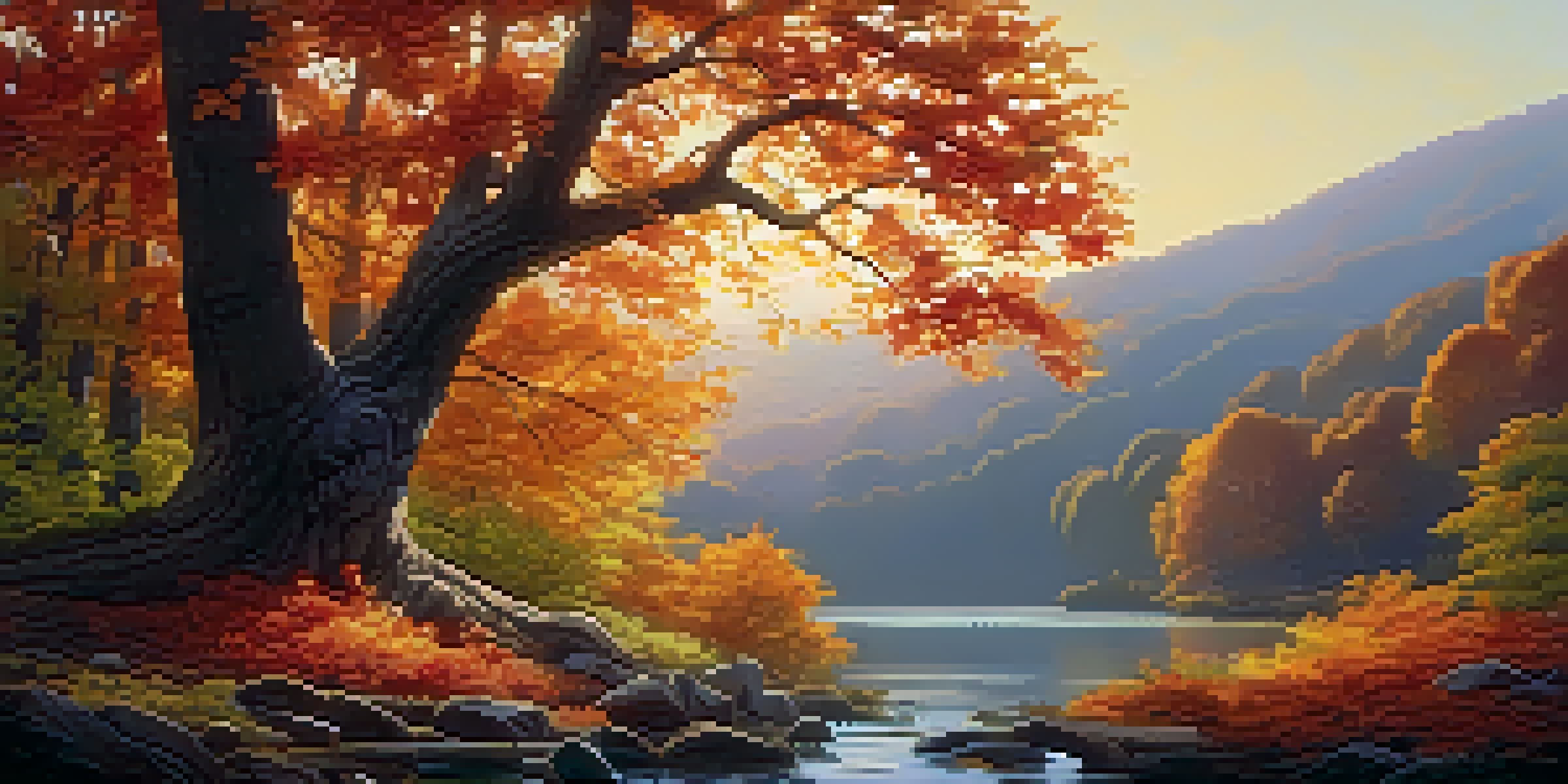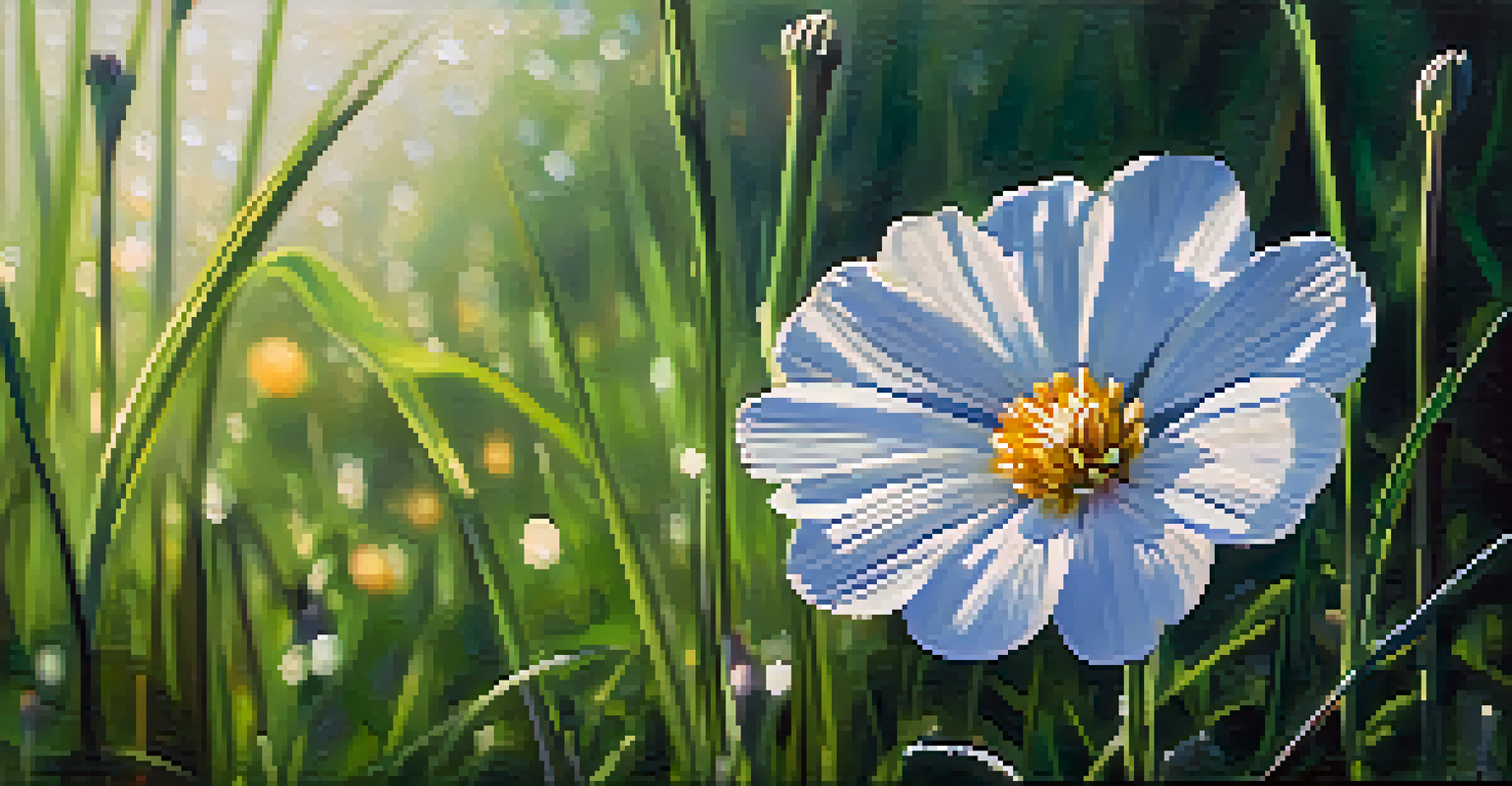The Role of Nature in Transcendentalist Art Movements

Understanding Transcendentalism and Its Roots
Transcendentalism, emerging in the early 19th century, was a philosophical movement that emphasized the inherent goodness of people and nature. Think of it as a reaction against the industrial revolution, where many felt disconnected from their surroundings. Influential figures like Ralph Waldo Emerson and Henry David Thoreau championed this ideology, advocating for a deeper connection with the natural world.
In the presence of nature, a wild delight runs through the man, in spite of real sorrows.
At its core, transcendentalism encouraged individuals to seek truth and beauty in nature, rather than solely through societal norms or material possessions. This perspective reshaped the way artists perceived their environment, prompting them to explore themes of spirituality and individuality. Nature was not just a backdrop; it became a central character in their artistic narratives.
By understanding the philosophical underpinnings of transcendentalism, we can appreciate how these ideas seamlessly flowed into various art movements. The desire to depict nature's beauty and complexity became a defining feature in the works of many transcendentalist artists, ultimately shaping their creative expression.
Nature as a Source of Inspiration
For transcendentalist artists, nature wasn’t just a theme; it was a vital source of inspiration that sparked creativity. Many artists sought to capture the beauty of landscapes, flora, and fauna, often portraying them with a sense of reverence. This approach reflects the belief that nature could enlighten the human spirit and provide profound insights into life.

Consider the works of artists like Thomas Cole, who painted breathtaking landscapes that celebrated the majesty of the American wilderness. His paintings often depicted nature as a reflection of divine beauty, inviting viewers to engage with the sublime. Through his art, Cole encouraged a deeper appreciation for the environment and its spiritual significance.
Nature Inspires Transcendental Art
Transcendentalist artists viewed nature as a vital source of inspiration, believing it could enlighten the human spirit and convey profound insights.
This connection with nature fostered a movement where artists began to see themselves as stewards of the earth. They understood that their art could not only reflect beauty but also evoke a greater consciousness regarding nature's role in human existence.
Symbolism of Nature in Art
In transcendentalist art, nature often serves as a powerful symbol representing various themes such as freedom, purity, and the divine. Artists utilized elements of the natural world to convey complex emotions and philosophical ideas, creating a rich tapestry of meaning. For instance, a single tree could represent strength and resilience, while a flowing river might symbolize the passage of time and life's journey.
I took a walk in the woods and came out taller than the trees.
This symbolic use of nature allowed artists to communicate with their audience on a more profound level. Viewers were invited to interpret the artwork through their own experiences, making each piece a unique dialogue between the artist and the observer. The beauty of nature became a universal language that transcended cultural barriers.
Additionally, the symbolism in transcendentalist art encouraged a reflective relationship between humanity and the environment. By presenting nature as a living entity with its own narrative, artists urged society to recognize and respect the interconnectedness of all life.
The Impact of Nature on Artistic Techniques
The transcendentalist movement also influenced the techniques artists employed to depict nature in their work. Many artists began experimenting with light, color, and perspective to capture the essence of the natural world more vividly. This shift marked a departure from traditional, realistic representations, allowing for a more emotive and expressive portrayal of landscapes.
For example, the use of soft brush strokes and vibrant hues in the works of the Hudson River School artists created a sense of movement and life within nature. These techniques not only enhanced the visual appeal of the artwork but also conveyed the emotional weight of the scenes being depicted. Artists aimed to evoke feelings of awe and wonder in their viewers.
Art as Critique of Industrialization
Through their works, transcendentalist artists critiqued the rapid industrialization of the 19th century, contrasting urban chaos with the tranquility of untouched nature.
Through innovative techniques, transcendentalist artists transformed the way nature was represented in art. Their commitment to capturing the spirit of the natural world helped to elevate the status of landscape painting and inspired future generations of artists to explore similar themes.
Nature's Role in Spiritual Exploration
For many transcendentalists, nature was a pathway to spiritual exploration and self-discovery. Artists believed that by immersing themselves in the natural environment, they could gain insights into their own existence and the larger universe. This quest for spiritual truth often manifested in their artwork, which sought to portray the beauty and mystery of the natural world.
Take, for instance, the works of John Muir, a naturalist and writer whose passion for nature transcended into poetic expressions of the wilderness. His writings and sketches captured not only the physical beauty of the landscapes but also the profound sense of peace and connection he felt within them. This intertwining of art and spirituality created a unique narrative that resonated with many.
By embracing nature as a spiritual guide, transcendentalist artists encouraged others to seek their own connections with the world around them. This emphasis on spirituality through nature continues to influence contemporary art movements and invites individuals to explore their relationship with the environment.
Critique of Industrialization Through Nature
Transcendentalist artists often used their work to critique the rapid industrialization of the 19th century, highlighting the stark contrast between urban development and the serenity of nature. As cities expanded and machinery replaced natural landscapes, these artists sought to remind society of the beauty and tranquility found in the wilderness. Their art served as a call to preserve and appreciate the natural environment.
Artists like Frederic Edwin Church created works that celebrated untouched landscapes, contrasting the chaos of urban life with the peacefulness of nature. His stunning depictions of places like the Andes Mountains and Niagara Falls not only showcased their beauty but also served as a poignant reminder of what was at stake during this era of industrial expansion.
Legacy of Nature in Modern Art
The influence of transcendentalism continues in contemporary art, where nature remains a central theme advocating for environmental awareness and sustainability.
Through their critique of industrialization, transcendentalist artists played a crucial role in the early conservation movement. They inspired viewers to reflect on their relationship with nature and encouraged a collective responsibility to protect the environment for future generations.
Legacy of Nature in Transcendentalist Art
The legacy of nature in transcendentalist art continues to resonate in contemporary society, reminding us of the importance of connecting with our environment. Today, many artists still draw inspiration from nature, using their work to advocate for environmental awareness and sustainability. This ongoing relationship highlights the timeless themes of transcendentalism that are still relevant.
Moreover, the transcendentalist emphasis on nature has influenced other art movements, such as Impressionism and Romanticism, which also celebrated the beauty of the natural world. These movements built upon the foundations laid by transcendentalist artists, further evolving our understanding and appreciation of nature in art.

Ultimately, the role of nature in transcendentalist art serves as a poignant reminder of our interconnectedness with the environment. As we navigate the complexities of modern life, the lessons learned from these artists encourage us to pause, reflect, and find inspiration in the world around us.